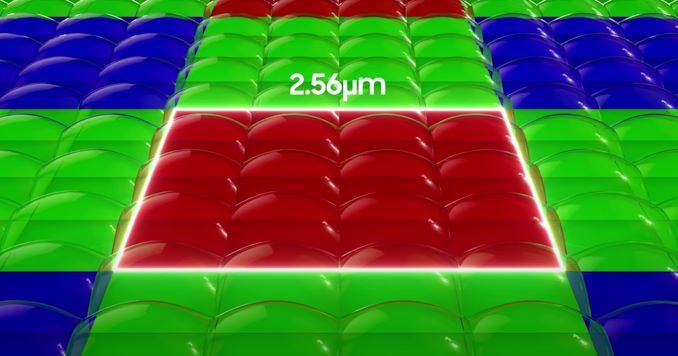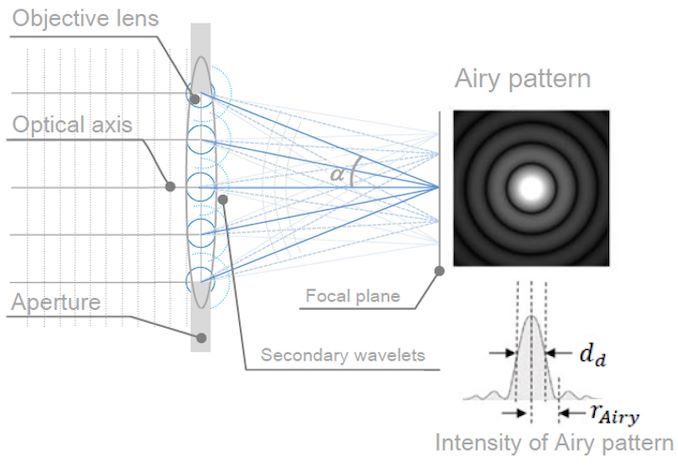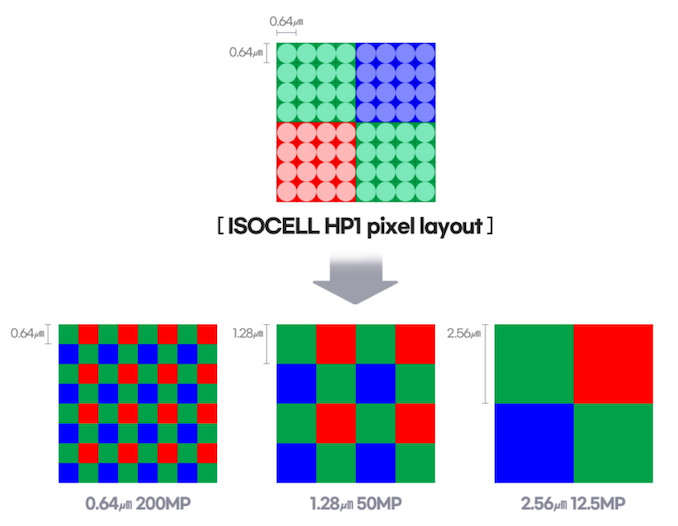Samsung's new 200MP HP1 Sensor: Sensible, or Marketing?
by Andrei Frumusanu on September 23, 2021 10:00 AM EST- Posted in
- Mobile
- Smartphones
- Camera Sensors
- Sensors
- Samsung HP1

This week, Samsung LSI announced a new camera sensor that seemingly is pushing the limits of resolution within a mobile phone. The new S5KHP1, or simply HP1 sensor, pushes the resolution above 200 megapixels, almost doubling that of what’s currently being deployed in contemporary hardware in today’s phones.
The new sensor is interesting because it marks an implementation of a new binning mechanism, beyond the currently deployed Quad-Bayer (4:1 pixel binning) or “Nonapixel” (9:1 binning), but a new “ChameleonCell” binning mechanism that is both able to employ 4:1 binning in a 2x2 structure, as well as 16:1 binning in a 4x4 structure.
We’ve been familiar with Samsung’s 108MP sensors for a while now as they’ve seen adoption for over two years both in Samsung Mobile phones as well as in Xiaomi devices, although in slightly different sensor configurations. The most familiar implementation is likely the HM1 and HM3 modules in the S20 Ultra and S21 Ultra series, which implement the “Nonapixel” 9:1 pixel binning technique to aggregate 9 pixels into 1 for regular 12MP captures in most scenarios.
One problem with the 9:1 scheme was that you’re effectively having to magnify 3x in relation between the two resolution modes, and for devices such as the S21 Ultra, this was mostly a redundant mode of functioning as the phone had a dedicated 3x telephoto module to achieve a similar pixel spatial resolution, at a larger pixel size.
8K video recording was a use-case for when the native 108MP resolution made sense, however even here the problem is that the native resolution is far above the required 33MP for 8K video, meaning the phone had to suffer a very large field of view crop as it didn’t support resolution super sampling down from 108MP to 33MP.
| Sensor Solution Comparisons | |||||||||
| Optics | Sensor | ||||||||
| 35mm eq. FL |
FoV (H/V/D) |
Aperture - Airy Disk |
Resolution | Pixel Pitch |
Pixel Res. |
Sensor Size |
|||
| HP1 (Theoretical) |
24.17 | 71.2° 56.5° 83.7° |
~f/1.9 - 1.15µm |
201.3M native (16384 x 12288) 50.3M 2x2 bin (8192 x 6144) 12.6M 4x4 bin (4096 x 3072) |
0.64µm 1.28µm 2.56µm |
15.2″ 30.4" 60.9″ |
1 / 1.22" 10.48mm x 7.86mm 82.46mm² |
||
| HM3 (S21 Ultra) |
24.17 | 71.2° 56.5° 83.7° |
f/1.8 - 1.09µm |
108.0M native (12000 x 9000) 12.0M 3x3 bin (4000 x 3000) |
0.8µm 2.4µm |
21.4″ 64.1″ |
1 / 1.33" 9.60mm x 7.20mm 69.12mm² |
||
| GN2 (Mi 11 Ultra) |
23.01 | 73.9° 58.9° 86.5° |
f/1.95 - 1.18µm |
49.9M native (8160 x 6120) 12.5MP 2x2 bin (4080 x 3060) |
1.4µm 2.8µm |
32.6″ 65.2″ |
1 / 1.12" 11.42mm x 8.56mm 97.88mm² |
||
| S21U 3x Telephoto |
70.04 (4:3) |
27.77° 21.01° 34.34° (4:3) |
f/2.4 - 1.46µm |
10.87M native (3976 x 2736) 9.99M 4:3 crop (3648 x 2736) 12M scaled (4000 x 3000) |
1.22µm | 27.4″ | 1 / 2.72" 4.85mm x 3.33mm 16.19mm² |
||
| S21U 10x Telephoto |
238.16 (4:3) |
8.31° 6.24° 10.38° (4:3) |
f/4.9 - 5.97µm |
10.87M native (3976 x 2736) 9.99M 4:3 crop (3648 x 2736) 12M scaled (4000 x 3000) |
1.22µm | 8.21″ | 1 / 2.72" 4.85mm x 3.33mm 16.19mm² |
||
The new HP1 sensor now has two binning modes: 4:1 and 16:1. The 4:1 mode effectively turns the 201MP native resolution to 50MP captures, and when cropping into a 12.5MP view frame, would result in a 2x magnification which would be more in line with what we’re used to in Quad-Bayer sensors. In fact, the results here would be pretty much in line with Quad-Bayer sensors as the native colour filter of the HP1 is still only 12.5MP, meaning a single R/G/B filter site covers 16 native pixels.
A 4:1 / 2x2 binning mode is more useful, as generally the quality here is still excellent and allows mobile vendors to support high-quality 2x magnification capture modes without the need of an extra camera module, it’s something that’s being used by a lot of devices, but had been missing from Samsung’s own 108MP 3x3 binning sensors because of the structure compromise. Samsung LSI here even states that the HP1 would be able to achieve 8K video recording with much less of a field of view loss due to the lesser cropping requirements.
200MP - Potentially pointless?
This leads us to the actual native resolution of the sensor, the 201MP mode; here, native pixel pitch of the sensor is only 0.64µm, which is minuscule and the smallest we’ve seen in the industry. What’s also quite odd here, is that the colour resolution is spatially 4x lower due to the 2.56µm sized colour filter, so the demosaicing algorithm has to do more work than the usual Quad-Bayer or Nonapixel implementations we’ve seen to date.

Source: JEOL
At such small pixel pitches, we’re running into different problems, and that is the diffraction limit. Usually, such large sensors are employed as the “wide” angle module so they typically have apertures between f/1.6 and f/1.9 – the HP1 is a 1/1.22” optical format sensor that’s 19% larger than the HM3 in the S21 Ultra, so maybe a f/1.9 aperture is more realistic. The maximum intensity centre diameter of the airy disk at f/1.9 would be 1.15µm, and generally we tend to say that the diffraction limit where spatial resolution gets noticeably degraded is at twice the size of that – around 2.3µm, that’s well beyond the 0.64µm pixel size of the sensor.
The 200MP mode might have some slight benefits and be able to resolve things better than 50MP, however I very much doubt we’ll see much advantages over current 108MP sensors. In that sense, it appears to me to be a pretty pointless mode.

Top: 3.76µm native pixels at f/6.4 (7.8µm airy disk - 2.07x ratio) - Original
Bottom: 1.22µm native pixels at f/4.9 (5.9µm airy disk - 4.83x ratio) - Original
That being said, we do actually see camera implementations in the market that are far above the diffraction limit in terms of their sensor pixel size and optics. For example, above I took out two 1:1-pixel crops – one from an actual camera and lens, and one from the Galaxy S21 Ultra’s periscope module. In theory, we should be seeing somewhat similar resolution, glass optics quality aside, however it’s evident that the S21U is showcasing a far lower actual spatial resolution. One big reason here is again the diffraction limit, where the S21U’s periscope at 1.22µm pixels and f/4.9 aperture has an airy disk of 5.9µm, or 4.82x the size of the pixel, meaning that physically the incoming light cannot be resolved more than at a quarter the resolution of the actual sensor.
To be able for the HP1 sensor to take advantage of its 200MP mode, it would need to have a very large aperture optics to avoid diffraction, a very high-quality glass to actually even resolve the details, and to not be in very demanding high dynamic range scenarios, due to the extremely low full well capacity of the small pixels.
To alleviate dynamic range concerns, Samsung does state that the sensor has the newest technologies included: better deep trench isolation (“ISOCELL 3.0”) should increase the full well capacity of the pixels, while also support dual gain converters (Smart-ISO Pro) as well as staggered HDR capture.
The one thing the sensor would lack in terms of more modern features is full-sensor dual pixel autofocus, with Samsung noting it instead uses “Double Super PD”, with double the dedicated PD sites as the existing Super PD implementations such as on the HM3.
Overall, the HP1 seems interesting, however I can’t shake it off that the 200MP mode of the sensor will have very little practical benefits. In theory, a device would be able to cover the magnification range from 1x to ~5x with quite reasonable quality and maybe avoid having a dedicated mode in that focal length, however we’ll have to see how vendors design their camera systems around the sensor. The new 2x2 binning mode however is welcome, simply due to the fact that it’s a lot more versatile than the 3x3 mode in current 108MP sensors, and should allow real world large benefits to the camera experience, even if the native 200MP mode doesn’t pan out as advertised.











44 Comments
View All Comments
melgross - Thursday, September 23, 2021 - link
Considering that the highest sensor rez on full frame 35 digital is 60MP, and the highest for a full sized medium format sensor is currently 150MP, both requiring very high quality lenses to achieve those resolutions, we can see that this is just another Samsung sales gimmick.Around 45MP is needed for full frame 8K recording.
boozed - Friday, September 24, 2021 - link
Lenses for SLRs were always big, complicated and expensive because of the minimum back focus length required for the rear element of the lens to clear the swinging mirror. This required complicated optical formulae, especially for short focal length lenses, which in turn required even more lens elements to correct the distortions and aberrations that caused. And if you want a zoom lens, well...However, it is a lot easier and cheaper to design and manufacture high quality fixed focal length short back focus lenses for very small sensors.
That said, I still don't understand what Samsung is trying to achieve here.
drajitshnew - Saturday, September 25, 2021 - link
Short back focus was touted as a key advantage of mirrorless cameras. But while current SLR lenses can keep up with current sensors, they are way more expensive and complicated.melgross - Tuesday, September 28, 2021 - link
Back focal length has little, if nothing to do with the complexity of lenses. It’s a matter of lens speed and resolving power. Microscope lenses, for example, use a very thin oil to connect the lens surface to the slide, but have a very high N.A, and can have ten elements, or more.Tessar lenses have just four elements, and can have good sharpness and high contrast, but they’ve normally f 2.8 to 3.5. Higher speed designs are usually six or seven element Gauss designs. Lens design is a very complex subject. Trying to blame it on back focus depth is incorrect.
Byte - Tuesday, October 5, 2021 - link
Bragging rights, what else they got?ToTTenTranz - Thursday, September 23, 2021 - link
Aren't they needlessly losing actual sensor area because of the spacing between pixels?Surely the "50MPix mode" isn't really using the exact equivalent of a 1.28µm pixel pitch. How much sensor area is being lost here?
I can't help but feel like the GN2 sounds like the only sensible implementation here.
Andrei Frumusanu - Thursday, September 23, 2021 - link
https://www.techinsights.com/sites/default/files/2...The isolators are around 110-150nm wide, so yes, on a 0.64µm pixel that is actually quite a percentage unless they've shrunk things down even more on newer generation sensors. I don't think anybody expects the binned FWC to be similar to a larger pixel.
ToTTenTranz - Thursday, September 23, 2021 - link
So roughly 20% of the pixel area are being spent on isolators, i.e. not an area that is effective for the sensor.Wereweeb - Thursday, September 23, 2021 - link
That makes it even worse.Wereweeb - Thursday, September 23, 2021 - link
Not to mention that both the "200MP" and "50MP" images are actually "reconstituted" by AI, by re-arranging the sub-pixels around and running some AI on top of it.I wonder what the effect would be if instead of "muh 200 MP", they "fixed" Bayer sensors by using a sensor with 50MP that resolved down to 12.5MP by combining the individual colour pixels, instead of relying on de-mosaicing.